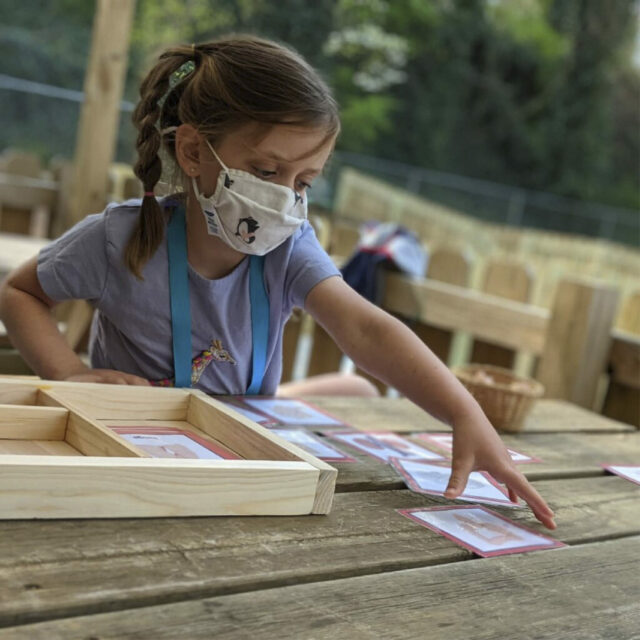Early Childhood

Philosophy & Structure
Montessori is an educational method that focuses on the individual child and his or her needs. The concepts behind this method were consolidated by Dr. Maria Montessori at the beginning of the 20th century. Her concepts in regards to teaching children based on their needs and personal interest led to the Montessori educational method that we use today. We begin students on their Montessori journey starting in early childhood and help them to gain a sense of independence, grow confidence, and develop a love of learning.
Each of our early childhood classrooms contains a robust curriculum including botany, zoology, experimental science, art and music (composition, theory, and appreciation), geography, history, sensorial materials, mathematics, language, and practical life.
Peer to Peer Learning
What is a typical morning like in a Montessori Early Childhood (3-6) classroom?
Curriculum
Practical Life
In this section of work, the child finds materials and exercises of their everyday life from pouring water from a jug to a glass or learning how to tie a shoelace. These activities help the child to properly take care of themselves so that they may feel independent and not have to rely on an adult for all of their basic needs which instill self-esteem.
Sensorial
Activities in this section allow the child to refine each of their senses. They will become a child who can appreciate color and texture differences, organize thoughts and objects in their environment and develop a refined sense of pitch from the music they may hear around them.
Language
The child is taught language through a specific progression of lessons where they first become aware of the different sounds in a word. The child then learns the language phonetically until the point where they are taught the different “rules” in a given language and the exceptions to those rules that they will need to know in order to spell and read fluently.
Mathematics
The child first learns to count from 1-10 through the understanding of the concept that numbers represent a specific amount. Through each material, the child will learn addition, subtraction, multiplication, and division to truly understand what each one means in their deeper sense. Through this method of teaching, Montessori offers the child a strong and solid foundation in the understanding of mathematical theory and application.

Philosophy & Structure
Montessori is an educational method that focuses on the individual child and his or her needs. The concepts behind this method were consolidated by Dr. Maria Montessori in the beginning of the 20th century. Her concepts in regards to teaching children based on their needs and personal interest led to the Montessori educational method that we use today. We begin students on their Montessori journey starting in early childhood and help them to gain a sense of independence, grow confidence, and develop a love of learning.
Each of our early childhood classrooms contains a robust curriculum including botany, zoology, experimental science, art and music (composition, theory, and appreciation), geography, history, sensorial materials, mathematics, language, and practical life. Our toddler and early childhood classrooms are located at our Garden Campus.
Each early childhood classroom contains a robust curriculum including botany, zoology, experimental science, art and music (composition, theory, and appreciation), geography, history, sensorial materials, mathematics, language, and practical life.
Peer to Peer Learning
What is a typical morning like in a Montessori Early Childhood (3-6) classroom?
Curriculum
Practical Life
In this section of work, the child finds materials and exercises of their everyday life from pouring water from a jug to a glass or learning how to tie a shoelace. These activities help the child to properly take care of themselves so that they may feel independent and not have to rely on an adult for all of their basic needs which instill self-esteem.
Sensorial
Activities in this section allow the child to refine each of their senses. They will become a child who can appreciate color and texture differences, organize thoughts and objects in their environment and develop a refined sense of pitch from the music they may hear around them.
Language
The child is taught language through a specific progression of lessons where they first become aware of the different sounds in a word. The child then learns the language phonetically until the point where they are taught the different “rules” in a given language and the exceptions to those rules that they will need to know in order to spell and read fluently.
Mathematics
The child first learns to count from 1-10 through the understanding of the concept that numbers represent a specific amount. Through each material, the child will learn addition, subtraction, multiplication, and division to truly understand what each one means in their deeper sense. Through this method of teaching, Montessori offers the child a strong and solid foundation in the understanding of mathematical theory and application.
Why Montessori?
Overall, what makes this method of learning so different compared to other conventional forms of early childhood education today? Our teachers do not stand in front of the class and teach each child the same lesson all at once. Each child is allowed to learn at their own rhythm in a way that allows them to feel as though they are not learning or being taught, but discovering the world. Even young children gain a sense of independence, curiosity, and esteem that is only accomplished through Dr. Montessori’s methodology with Little River. By starting Montessori Education at the beginning of a child’s academic journey, guardians can set their child up for success in many facets of their lives.